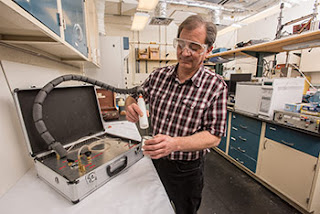NIST chemist Tom Bruno, who invented a method for recovering trace chemicals such as environmental pollutants and forensic evidence, uses a portable version of the instrument to sample vapor inside an old paint can. The underlying technique is called PLOT-cryoadsorption, or PLOT-cryo - short for porous layer open tubular cryogenic adsorption.
Photo credit: Courtesy NIST/ Photo by Dave Neligh
Topics: Chemistry, Environment, Forensics, NIST, Research
A chemist at the National Institute of Standards and Technology (NIST) has developed a portable version of his method for recovering trace chemicals such as environmental pollutants and forensic evidence including secret graves and arson fire debris.
If successfully commercialized by industry, the briefcase-sized kit could enable detectives, field inspectors and others to carry with them a convenient version of NIST’s “headspace analysis” technique, which identifies solid or liquid compounds based on the makeup of vapors released into nearby air.
The underlying technique is PLOT-cryoadsorption, or PLOT-cryo—short for porous layer open tubular cryogenic adsorption. PLOT-cryo is sensitive, quantitative and more broadly useful than many competing techniques. It can identify compounds that don’t readily evaporate and is not limited to samples dissolved in water, for example. The method recovers vapors by suction or by sweeping a gas across the air above a sample of interest. The laboratory version of the technique has been used to find traces of explosives, spoiled food, residues in arson debris and gravesoil.
NIST: Portable NIST Kit Can Recover Traces of Chemical Evidence, Laura Ost

Comments